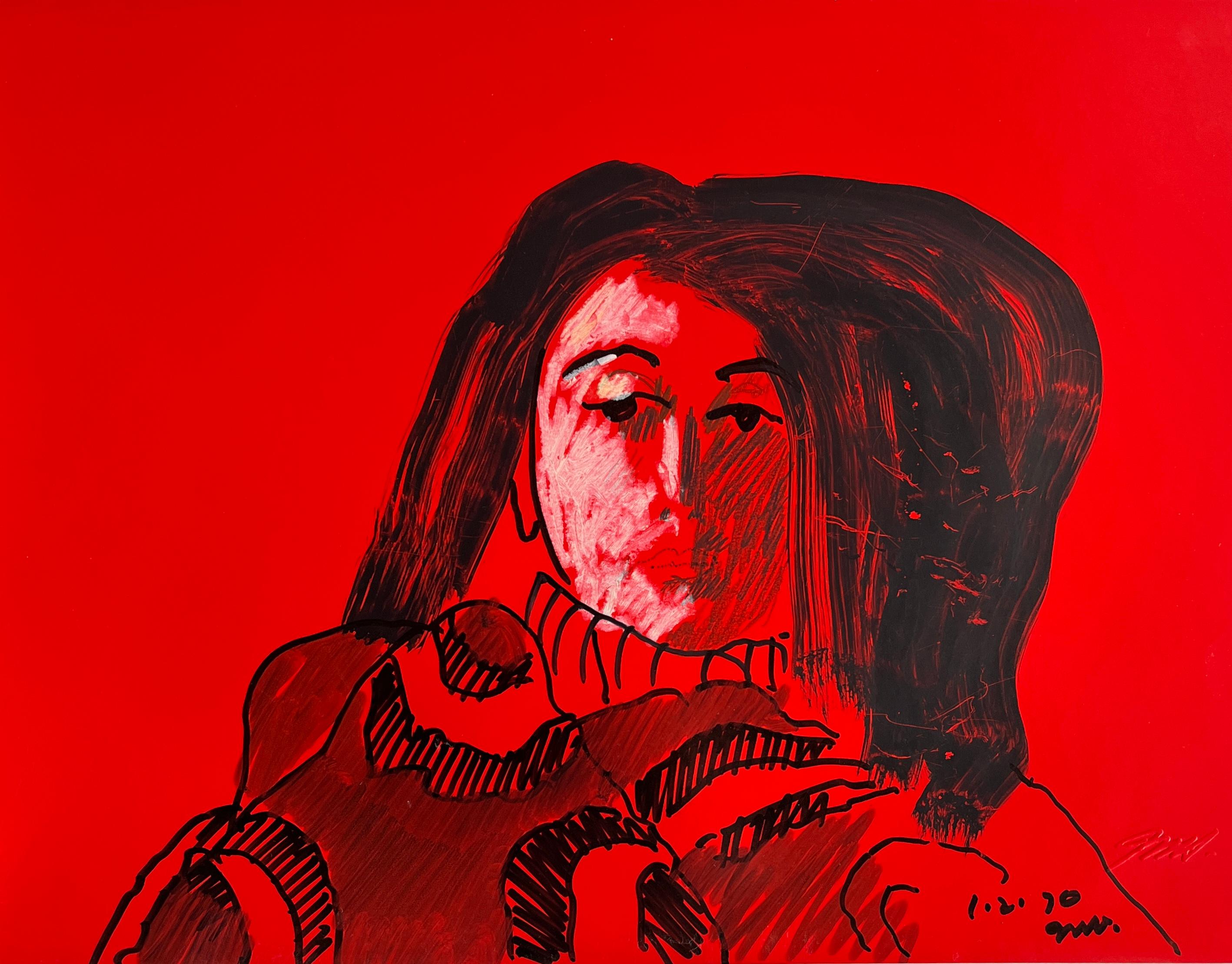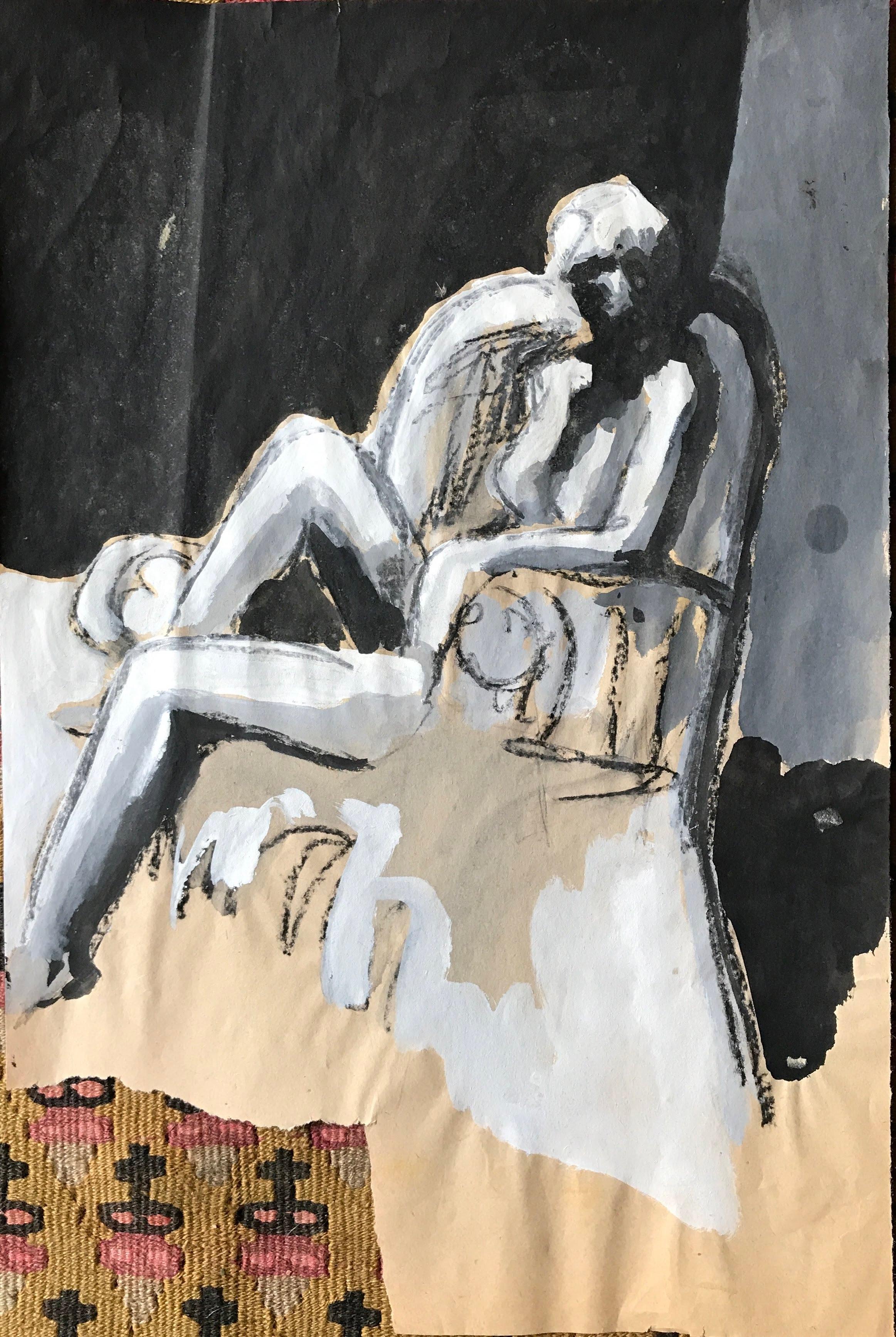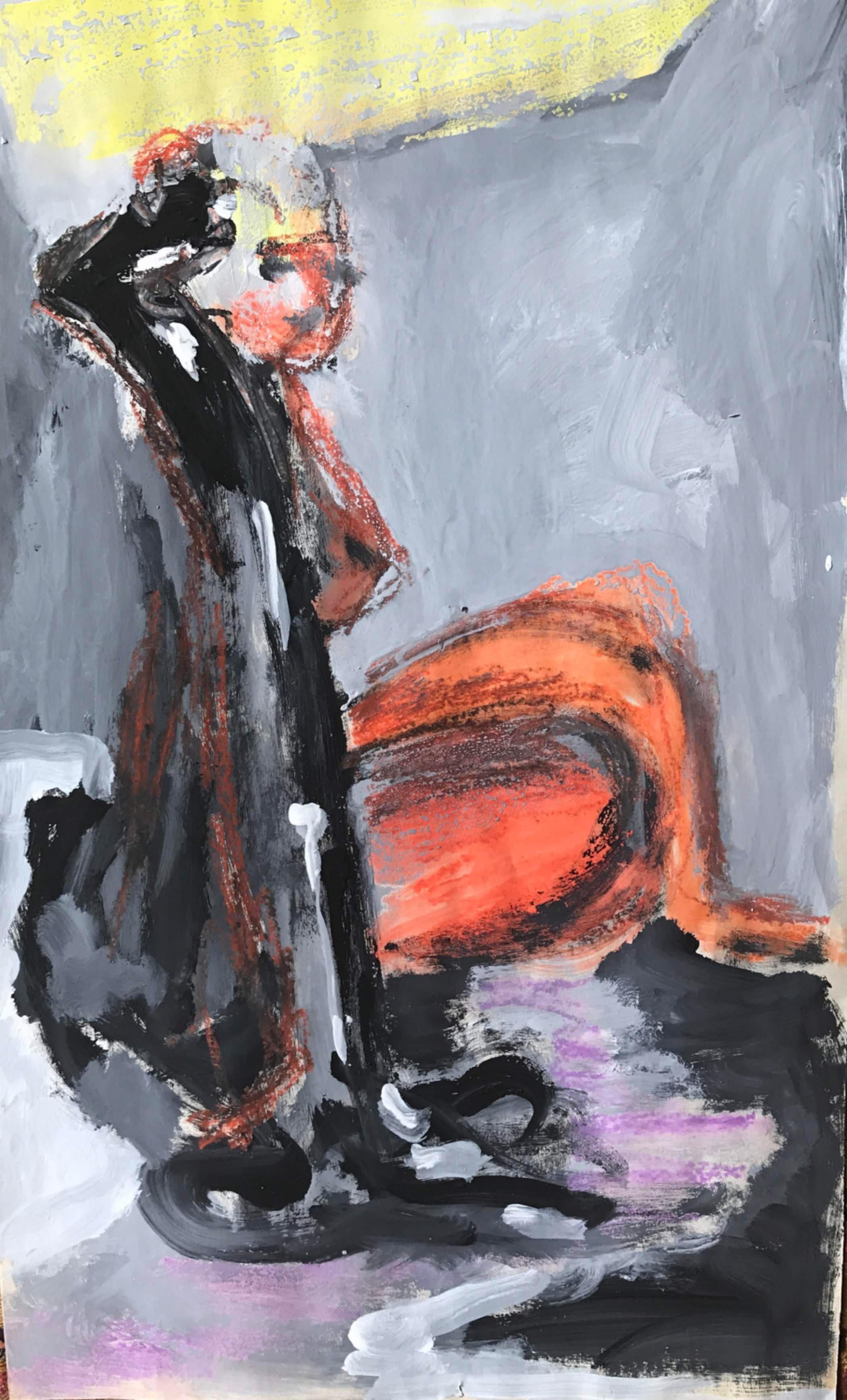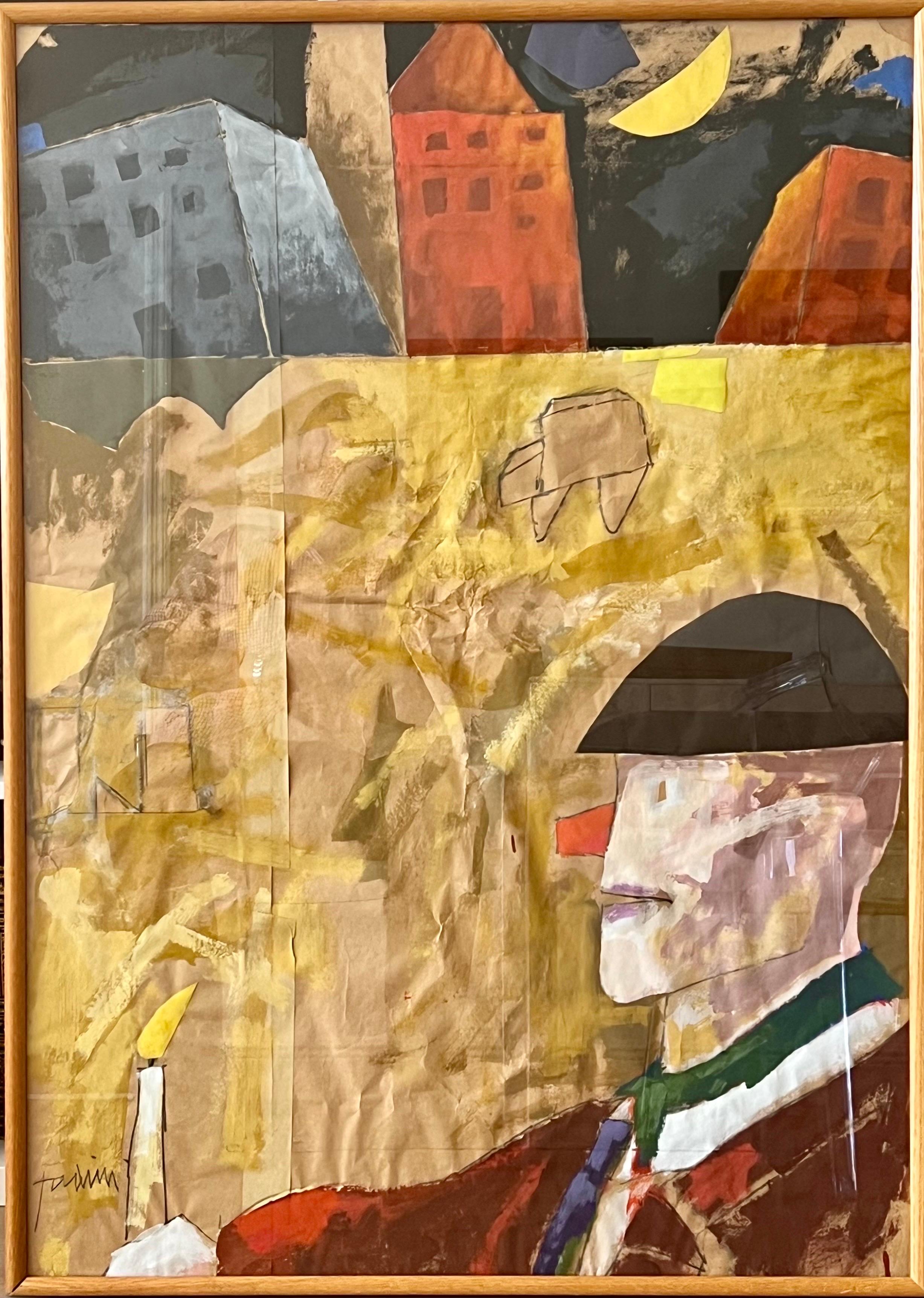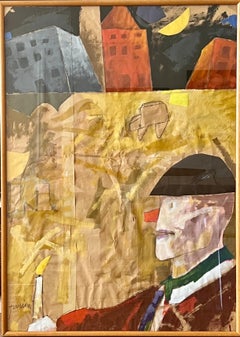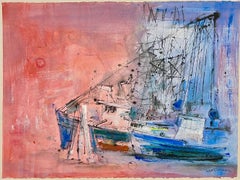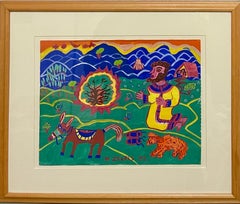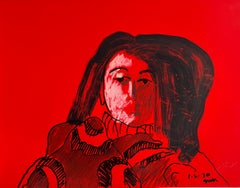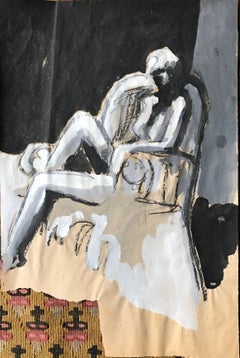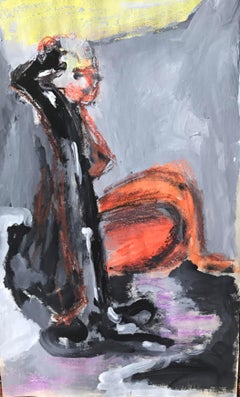Items Similar to Bauhaus Moshe Raviv Moi Ver Abstract Dancing Painting Lithuanian Israeli Modern
Want more images or videos?
Request additional images or videos from the seller
1 of 10
Moi Ver (Moshe Raviv Vorobeichic)Bauhaus Moshe Raviv Moi Ver Abstract Dancing Painting Lithuanian Israeli Modern
About the Item
Dancing Jesters or Clowns (colorful Chassidim dancing)
Gouache on paper
Sheet is 19.25 X 25.25
Image is 13.5 X 19.25
Moshé Raviv-Vorobeichic, known as Moi Ver, born Moses Vorobeichik (1904–1995) was an Israeli photographer and painter.
Moi Ver (Moshe Raviv) was born in 1904 in Vilnius, Lithuania as Moshe Vorobeichic.
Moshe Vorobeichic received his initial artistic training in the early 1920s in Vilnius, Lithuania, where he studied painting, architecture, and photography. Having become an important figure in the Yiddish avant-garde culture, he exhibited his first works. From October 1927, he studied at the Bauhaus school in Dessau (Germany), with photographer-visual artist Laszlo Moholy Nagy and painters Josef Albers, Paul Klee, Wassily Kandinsky, and Hinnerk Scheper.
In his book Moi Ver: Paris, he produced avant-garde photomontages. Originally published in 1931 by Editions Jeanne Walter with an introduction by futurist Fernand Leger.
In 1932 Raviv was sent by the weekly La Vie Parisienne to British Mandate Palestine as photo reporter. Raviv illustrated many books. Raviv was a founder of the Artists' Colony in Safed.
At the height of 20th Century modernism and one of the followers of Laszlo Moholy Nagy and his concept of New Vision, Moin Ver was one of the rising stars in European photography. Born in Lebedeva, in Belarus, he wandered through Europe until he immigrated to Palestine in 1934. His well known yet partly forgotten three photographic projects in 1931, The Ghetto Lane in Wilna, Paris: 80 Photographies de Moi Ver and Ci-Contre – 110 Photos de Moi Ver (that was not published at the time), have remained milestones in the art of the 1930s as he created and imposed a new visionary style in photography.
As a contemporary of artists such as Man Ray, Ilse Bing, Hannah Hoch, Andre Kertesz, Brassai, Germaine Krull and Dora Maar, who were all active in Paris at the same time and like most of them Moi Ver’s photographic vision was a combination of innovative painting and advanced unconventional camera practice that yielded radical images. Raviv's work is a perfect example of the modernist movement of the early 20th century and reflects the social, cultural, and artistic changes that were taking place at the time.
Decades ahead of his time, the collage, multiple exposures and combination prints he produced were a vibrant depiction of the dynamism of the modern metropolis and are still relevant and modern as an advanced form of photographic expression which has influenced since then generations of photographers. In 1934 he immigrated to what was then known as Palestine.
In 1937 he undertook a report on agricultural farms (hakhsharot or kibbutzim) for the training of young Zionists emigrating to Palestine. These images bear testimony to pre-war Jewish life in Eastern Europe. They were published during the 1930s and 1940s in the press and in various books in Poland, France and Palestine, where he had lived since 1934. Moshe Raviv-Vorobeichic (as he called himself in Israel) He photographed the “new migrants”, the construction of infrastructures, and the daily life in kibbutzim. These novel images were later published in books and informational brochures; they also served as raw material to produce political posters. In the early 1950s, at the age of fifty, Vorobeichic adopted the name Moshe Raviv and left Tel Aviv for the village of Safed, in the north of the country, near Lake Tiberias. Moshe Raviv joined the Jewish artistic community in Safed, which had been very active since the 1930s. He gradually abandoned photography and graphic design, returning to oil painting and dabbling with drawing and engraving. His works reveal multiple influences: expressionism, popular Yiddish literature, modernism, and even the esoteric kabbalistic tradition. While some of them include figurative references, such as landscapes, religious figures, and places of study, most of them are abstracts reminiscent of his first paintings from the 1920s.
Education
Graduated from the first Hebrew Gymnasium in the Diaspora
Art and architecture, Vilnius University
1928 Bauhaus, Dessau, Germany with Paul Klee, Wassily Kandinsky, and Joseph Albers
1930 Ecole Photo Cine, Paris, photography
- Creator:Moi Ver (Moshe Raviv Vorobeichic) (1904 - 1995, Lithuanian, Israeli)
- Dimensions:Height: 19.25 in (48.9 cm)Width: 25.25 in (64.14 cm)
- Medium:
- Movement & Style:Bauhaus
- Period:
- Condition:
- Gallery Location:Surfside, FL
- Reference Number:1stDibs: LU38212658712
About the Seller
4.9
Platinum Seller
Premium sellers with a 4.7+ rating and 24-hour response times
Established in 1995
1stDibs seller since 2014
1,745 sales on 1stDibs
Typical response time: 2 hours
- ShippingRetrieving quote...Shipping from: Surfside, FL
- Return Policy
Authenticity Guarantee
In the unlikely event there’s an issue with an item’s authenticity, contact us within 1 year for a full refund. DetailsMoney-Back Guarantee
If your item is not as described, is damaged in transit, or does not arrive, contact us within 7 days for a full refund. Details24-Hour Cancellation
You have a 24-hour grace period in which to reconsider your purchase, with no questions asked.Vetted Professional Sellers
Our world-class sellers must adhere to strict standards for service and quality, maintaining the integrity of our listings.Price-Match Guarantee
If you find that a seller listed the same item for a lower price elsewhere, we’ll match it.Trusted Global Delivery
Our best-in-class carrier network provides specialized shipping options worldwide, including custom delivery.More From This Seller
View AllItalian Pop Art Mixed Media Surrealist Painting Collage Gouache Emilio Tadini
By Emilio Tadini
Located in Surfside, FL
Emilio Tadini (1927-2002)
Original Collage, Gouache and Watercolor painting.
Dimensions: 41 X 29.5. framed. 39.75 X 28 artwork
Emilio Tadini (1927 – 2002 ) was an Italian painter,...
Category
20th Century Surrealist Mixed Media
Materials
Paint, Paper, Mixed Media, Watercolor, Gouache
Rare Modernist Hungarian Rabbi Pastel Drawing Gouache Painting Judaica Art Deco
By Hugó Scheiber
Located in Surfside, FL
Rabbi in the synagogue at prayer wearing tallit and tefillin.
Hugó Scheiber (born 29 September 1873 in Budapest – died there 7 March 1950) was a Hungarian modernist painter.
Hugo Scheiber was brought from Budapest to Vienna at the age of eight where his father worked as a sign painter for the Prater Theater. At fifteen, he returned with his family to Budapest and began working during the day to help support them and attending painting classes at the School of Design in the evening, where Henrik Papp was one of his teachers. He completed his studies in 1900. His work was at first in a post-Impressionistic style but from 1910 onward showed his increasing interest in German Expressionism and Futurism. This made it of little interest to the conservative Hungarian art establishment.
However, in 1915 he met the great Italian avant-gardist Filippo Tommaso Marinetti and the two painters became close friends. Marinetti invited him to join the Futurist Movement. The uniquely modernist style that he developed was, however, closer to German Expressionism than to Futurism and eventually drifted toward an international art deco manner similar to Erté's. In 1919, he and his friend Béla Kádar held an exhibition at the Hevesy Salon in Vienna. It was a great success and at last caused the Budapest Art Museum to acquire some of Scheiber's drawings. Encouraged, Scheiber came back to live in Vienna in 1920.
A turning point in Scheiber's career came a year later, when Herwarth Walden, founder of Germany's leading avant-garde periodical, Der Sturm, and of the Sturm Gallery in Berlin, became interested in Scheiber's work. Scheiber moved to Berlin in 1922, and his paintings soon appeared regularly in Walden's magazine and elsewhere. Exhibitions of his work followed in London, Rome, La Paz, and New York.
Scheiber's move to Germany coincided with a significant exodus of Hungarian artists to Berlin, including Laszlo Moholy-Nagy and Sandor Bortnyik. There had been a major split in ideology among the Hungarian avant-garde. The Constructivist and leader of the Hungarian avantgarde, Lajos Kassák (painted by Hugó Scheiber in 1930) believed that art should relate to all the needs of contemporary humankind. Thus he refused to compromise the purity of his style to reflect the demands of either the ruling class or socialists and communists. The other camp believed that an artist should be a figurehead for social and political change.
The fall out and factions that resulted from this politicisation resulted in most of the Hungarian avant gardists leaving Vienna for Berlin. Hungarian émigrés made up one of the largest minority groups in the German capital and the influx of their painters had a significant effect on Hungarian and international art. Another turning point of Scheiber's career came in 1926, with the New York exhibition of the Société Anonyme, organized by Katherine Dreier. Scheiber and other important avant garde artists from more than twenty-three countries were represented. In 1933, Scheiber was invited by Marinetti to participate in the great meeting of the Futurists held in Rome in late April 1933, Mostra Nazionale d’Arte Futurista where he was received with great enthusiasm. Gradually, the Hungarian artists began to return home, particularly with the rise of Nazism in Germany. Kádar went back from Berlin in about 1932 and Scheiber followed in 1934.
He was then at the peak of his powers and had a special flair in depicting café and cabaret life in vivid colors, sturdily abstracted forms and spontaneous brush strokes. Scheiber depicted cosmopolitan modern life using stylized shapes and expressive colors. His preferred subjects were cabaret and street scenes, jazz musicians, flappers, and a series of self-portraits (usually with a cigar). his principal media being gouache and oil. He was a member of the prestigious New Society of Artists (KUT—Képzőművészek Új Társasága)and seems to have weathered Hungary's post–World War II transition to state-communism without difficulty. He continued to be well regarded, eventually even receiving the posthumous honor of having one of his images used for a Russian Soviet postage stamp (see image above). Hugó Scheiber died in Budapest in 1950.
Paintings by Hugó Scheiber form part of permanent museum collections in Budapest (Hungarian National Museum), Pecs (Jannus Pannonius Museum), Vienna, New York, Bern and elsewhere. His work has also been shown in many important exhibitions, including:
"The Nell Walden Collection," Kunsthaus Zürich (1945)
"Collection of the Société Anonyme," Yale University Art Gallery, New Haven, Connecticut (1950)
"Hugó Scheiber: A Commemorative Exhibition," Hungarian National Museum, Budapest (1964)
"Ungarische Avantgarde," Galleria del Levante, Munich (1971)
"Paris-Berlin 1900-1930," Centre Georges Pompidou, Paris (1978)
"L’Art en Hongrie, 1905-1920," Musée d’Art et l’Industrie, Saint-Etienne (1980)
"Ungarische Avantgarde in der Weimarer Republik," Marburg (1986)
"Modernizmus," Eresz & Maklary Gallery, Budapest (2006)
"Hugó Scheiber & Béla Kádár," Galerie le Minotaure, Paris and Tel Aviv (2007)
Hugó Scheiber's paintings continue to be regularly sold at Sotheby's, Christie's, Gillen's Arts (London), Papillon Gallery (Los Angeles) and other auction houses.
He was included in the exhibition The Art Of Modern Hungary 1931 and other exhibitions along with Vilmos Novak Aba, Count Julius Batthyany, Pal Bor, Bela Buky, Denes Csanky, Istvan Csok, Bela Czobel, Peter Di Gabor, Bela Ivanyi Grunwald, Baron Ferenc Hatvany, Lipot Herman, Odon Marffy, C. Pal Molnar...
Category
Early 20th Century Modern Figurative Paintings
Materials
Paper, Charcoal, Pastel, Watercolor, Gouache
Gouache Watercolor Painting, Nantucket Harbor Boats American Deaf Modernist Art
By Robert Freiman
Located in Surfside, FL
Abstract harbor scene with boats, in bold, vivid colors on heavy mould made paper.
Hand signed and dated, 1980
22 X 30 not frame
Robert Freiman, deaf from birth, was born in March 1917 in New York City. He attended an oral program near his home and later transferred to the Lexington School for the Deaf when he was six. Early in his childhood, his love for drawing, painting and studying became apparent, and as an adult, he continued his studies in New York at the National Academy of Design, Pratt Institute, the Art Students League and the Parsons School of Design. In Paris, France he studied at the Ecole des Beaux Arts. Bob Freiman was especially focused on painting portraits and figures in motion in various mediums, especially the mixed-media combination of watercolor, acrylic and pen. Among his subjects were acrobats, ballet dancers, cyclists and other athletes. He as well focused on abstracts for a time, discovering new media in his works with quick brushwork and expressive movements.
In the latter part of his career, his style became abstract and surreal with images of metaphysical landscapes with architectural elements such as arches, towers, pyramids and castles floating in the air. The famed art critic Pierre Rouve wrote: “It is therefore refreshing to see them revitalized by the colourist wealth and virile handwriting of Robert Freiman, probably the best American water-colorist since John Marin. He worked in Provincetown and Nantucket and regularly exhibited there. He showed at Doll & Richards gallery of Boston alongside John Chetcuti, Lloyd Goodrich, Tod Lindenmuth, William Meyerowitz, Dwight Shepler, Elizabeth O'Neill Verner, Stanley Woodward, Andrew Wyeth, and others. His work bears the influence of the mid century school of Paris in particular Jean Carzou. He was a regular exhibitor at the Sidewalk Art...
Category
1980s Expressionist Figurative Paintings
Materials
Watercolor, Gouache, Archival Paper
Malcah Zeldis Folk Art Gouache Moses Bible Painting Self Taught Outsider Artist
Located in Surfside, FL
MALCAH ZELDIS (American-Israeli, b. 1931)
Moses and the burning bush, 1982, gouache on paper,
Hand signed and dated lower middle.
Paper 9''h, 11-3/4''w...
Category
1980s Folk Art Figurative Paintings
Materials
Paper, Gouache
Malcah Zeldis Folk Art Gouache Painting King David Self Taught Outsider Artist
Located in Surfside, FL
MALCAH ZELDIS (American-Israeli, b. 1931),
''David and Saul'', 1982,
Gouache on paper
Hand signed and dated lower right, titled in pencil on paper verso...
Category
1980s Folk Art Figurative Paintings
Materials
Paper, Gouache
Malcah Zeldis Folk Art Gouache Painting Outsider Artist Circus Fire Eater, Tiger
Located in Surfside, FL
MALCAH ZELDIS
''Circus, Fire Eaters'', 1989, gouache on paper
Hand signed and dated bottom center, titled in pencil on paper verso
Paper 12''h, 9''w.
Provenance: Estate of Laura Fisher...
Category
1980s Folk Art Figurative Paintings
Materials
Paper, Gouache
You May Also Like
1970 "Muse on Red" Mixed Media Portrait of Woman American Modernist Jack Hooper
By Jack Hooper
Located in Arp, TX
Jack Hooper
"Woman on Red"
1/2/1970
Gouache, ink and pencil on glossy, red paper
11"x8.5" unframed
Signed and dated in ink lower right
In the year 1970, Jack Hooper's artistic prowe...
Category
Mid-20th Century American Modern Figurative Paintings
Materials
Paper, Gouache
"Leaning in Chair" Mid-Century Figurative
By Gloria Dudfield
Located in Arp, TX
Gloria Dudfield
Leaning in Chair
1960's
Gouache and Charcoal on Paper
11.75"x17.75" unframed.
Gloria (Fischer) Dudfield
July 12, 1922 – May 27, 2015
Came from a portfolio of her wor...
Category
Mid-20th Century Abstract Mixed Media
Materials
Paper, Charcoal, Gouache
$243 Sale Price
35% Off
Mid Century Figurative Painting Purple, Orange, Gray, Yellow Pastel and Paint
By Gloria Dudfield
Located in Arp, TX
Gloria Dudfield (1922-2015)
Untitled
c.1960s
Mixed media: gouache, pastel and encaustic on newsprint
12"x19.5" paper cut unevenly, unframed
Unsigned
Gloria (Fischer) Dudfield
July 1...
Category
Mid-20th Century Abstract Mixed Media
Materials
Paper, Pastel, Encaustic, Gouache
Sea Breeze
By Martina Niederhauser
Located in Los Angeles, CA
Internationally acclaimed artist Martina Niederhauser presents a new collection that offers fresh perspectives on women, delving into the realms of emotion, beauty, identity, and the...
Category
21st Century and Contemporary Contemporary Figurative Paintings
Materials
Canvas, Mixed Media, Oil, Acrylic, Gouache, Archival Paper
With All My Heart
By Martina Niederhauser
Located in Los Angeles, CA
Internationally acclaimed artist Martina Niederhauser presents a new collection that offers fresh perspectives on women, delving into the realms of emotion, beauty, identity, and the...
Category
21st Century and Contemporary Contemporary Figurative Paintings
Materials
Canvas, Mixed Media, Oil, Acrylic, Gouache, Archival Paper
Butterfly Eyes - Original Figurative Painting
By Martina Niederhauser
Located in Los Angeles, CA
Internationally acclaimed artist Martina Niederhauser presents a new collection that offers fresh perspectives on women, delving into the realms of emotion, beauty, identity, and the...
Category
21st Century and Contemporary Contemporary Figurative Paintings
Materials
Canvas, Mixed Media, Oil, Acrylic, Gouache, Archival Paper
